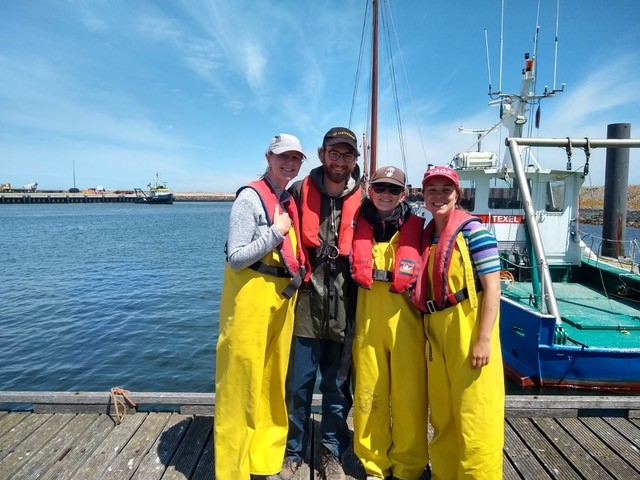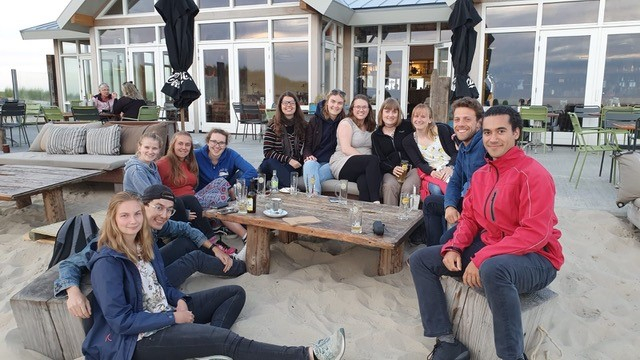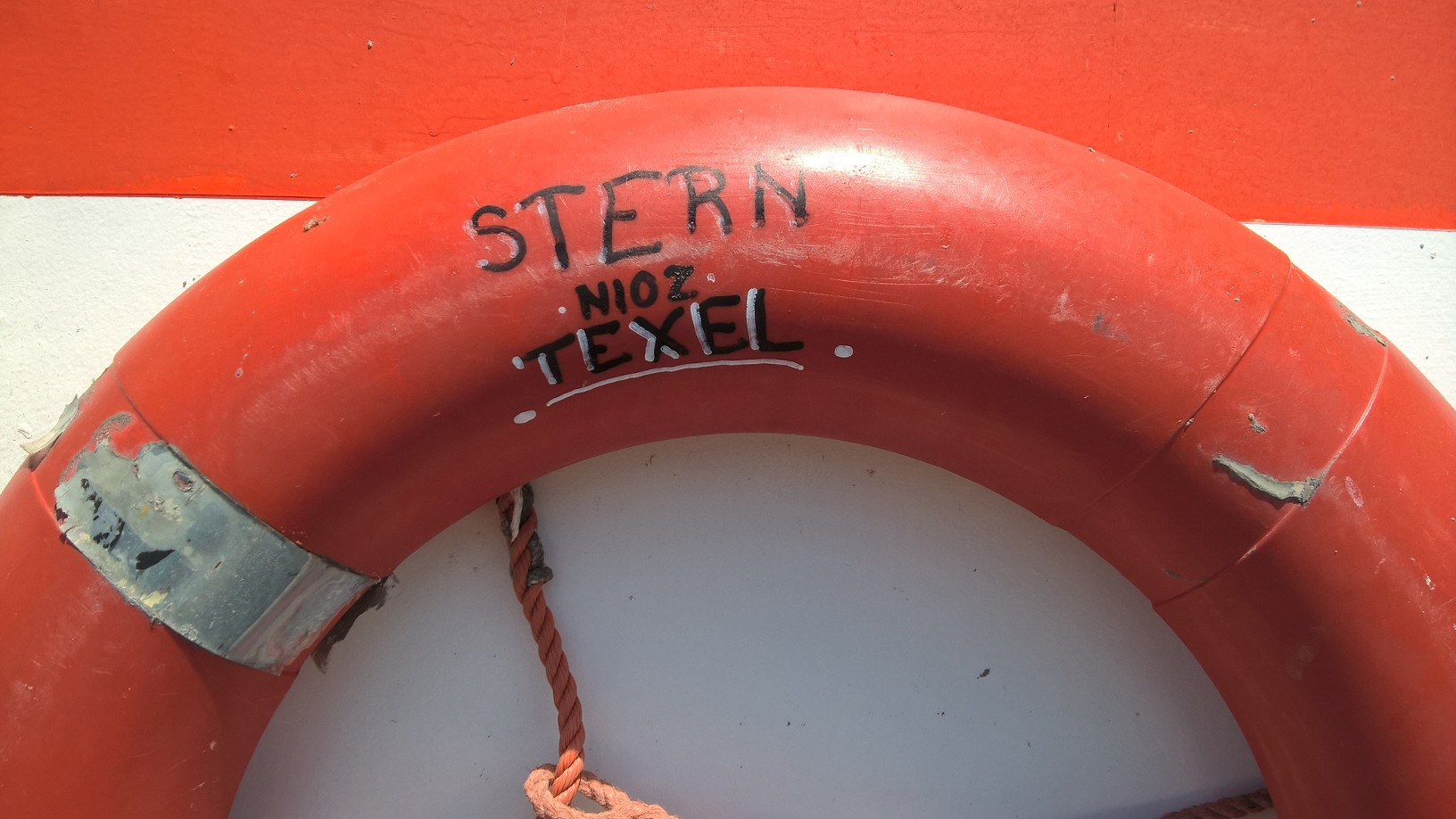Blog 5 | July 11th – My amazing stay at planet NIOZ
Surrounded by a group of giggling girls, a muscled man with half his body covered by tattoos and some beach boys whose skin tanned too much to match their sun bleached hair, I’m waiting for the ferry gates to open. Once on the island they have all disappeared without a trace. The air I am breathing is better than I’ve had for months now, in front of me dunes, behind me the tidal flats of the Wadden Sea. I am not sure where I am going to. Then, a small opening between two large sand dunes offers me an entrance, it turns out to be a gateway to another planet.
The people on my newly discovered planet all live in the same houses. Although some are larger than others and some live in it together, while others live by themselves. Might it be a matter of status? At first, most of the inhabitants seem to stick to the safe shelter between their walls, but at fixed times a large part of them goes outside. As a small flow of sediment on the bottom of the ocean they all go out and as if the tide has turned return later that day to find shelter again between their walls. Apart from that the outside world is dominated by dogs on balconies, in gardens, on leashes.
The next day I decide to find out where the flow is going. I just let myself be dragged and when I get back to my individual state of being I find myself right at the heart of this planet. This is where all the action is going on, machines are working hard, 24/7, being fuelled by human entries and solar panels. There seem to be thousands of little rooms, all with doors.
Behind the first door I find people dressed in white coats, they use tweezers where our hands would be, with which they sort out the tiniest of sea creatures into little cups. Behind the next door the ends of people’s arms consist of sharp needles. They stick them into bottles and then into machines, after which they stare for hours in the screens on which the machines seem to try to communicate with them.
I am getting a little hungry now and follow my nose to find some food. After passing the plastisphere of this planet, I see something that looks like a huge kettle of boiling soup. Although it is cold, the sea lettuce tastes very nice. With the last drops of salty seawater dripping from my chin I accidentally bump into one of the inhabitants. He invites me to go on a trip with him.
Too curious to refuse I follow the man onto a small boat, he throws in a net, pours the content into a bucket that leaks water through tiny little holes and then stores what is left in little labelled bags. Then we reach a larger ship and climb onto it. This ship is not moving, it has multiple cranes which are working hard on letting down and pulling up buckets of seawater and scoops of sediment from the bottom of the sea. With every move the crane makes, a signal is being given to a woman on the bridge of the ship behind a computer screen. I decide to go for a swim and go back on land to get some rest.
When I wake up a friendly man invites me into his room. He shows me his machine and explains to me how it uses radiation to identify different compounds. Then he introduces me to a woman who is working with another machine. For two days in a row she tells me all about her machine: how they work together and why she loves it so much. What she does for it and what it does for her. It is clear that the only motivation of sharing this information with me is the pure love in their relationship.
Unable to resist the attraction of this special place, I decide to stay for another week. It is clear to me that this is a very special planet: A planet where all its human inhabitants are contributing to the same goal, where the people have the same interests and are eager to share their knowledge with everyone who is willing to listen, a planet where humans and machines become one to create new knowledge about the marine environment.
Welcome to planet NIOZ!
By Sanne Bast, MSc student Environmental Sciences at the Open Universiteit
Blog 4 | July 5th – Impressions of the first week of the Marine Masters Summer Course
During the first week of the Marine Masters Summer Course, we have been introduced to different disciplines of ocean science and marine research. We have participated in field work such as sampling sediments, fauna and plastic on the tidal flats. We have also used the NIOZ research vessels Navicula and Stern to gather data and samples from the Wadden Sea, and some of us also got to take samples from rubber boats near the beach. The weather gods have been on our side this week, and we have had lots of sun (which for some of us has resulted in a sunburn).
It has been so much fun to try so many different types of sampling, and some of them have been brand new to me. The supervisors and staff from NIOZ have done a very good job explaining all the theory, helping with the practical work, and answering our questions.

But it has not only been all work! We ate our meals together at the NIOZ cafeteria, where we talked and relaxed. In the evenings we have done things such as riding our bikes, playing pool and other games at the Potvis campus. And, of course, we had to watch the FIFA Women’s World Cup, as The Netherlands were in the semifinals (and qualified for the finals)!
For me, one of the best parts of this course has been meeting all the other students from different universities and countries! We all have different degrees and approaches to marine science, but we all have a passion for the ocean! It is very interesting to see in how many different ways we can study the ocean, learning how to work together and combine our knowledge.
By Torunn Sandven Sagen, BSc student in Climate, Atmosphere and Ocean Physics at Bergen University, Norway

Blog 3 | July 3rd – An adventure in the mud
Today we went on an adventure in the Mokbaai, a bay very close to the Texel ferry harbour, to sample sediment, fauna and plastic. We went there in the afternoon during low tide. Having seen the bay during high tide yesterday morning, when I even went in for a swim (though it was quite shallow), it was amazing to see the difference; now almost the entire bay was dry, with water filling only a part in the middle. This allowed us to walk really far (and get stuck in the mud sometimes) and collect many samples for our research projects.
We picked up some pieces of plastic, both for our research and for contributing to clean seas; we found different species of animals, including crabs, jellyfish, a ‘sea needle’ (Syngnathus) and a baby starfish; and some of us even went up to their stomachs in the mud to collect sediment samples. After a few hours, we re-emerged from the mud and went to secure our samples at the NIOZ institute. It was great fun to study an environment that is so largely influenced by the tides and can look so different depending on the time of day.
By Miriam Sterl, BSc student in Physics, Astronomy and Mathematics at Utrecht University
Blog 2 | 2 July 2019 - Looking for plastic in the Wadden Sea
On the second day of the Marine Masters Summer Course, one of the activities performed by the students was to look for plastic in the Wadden Sea water. The students were divided into groups and mine was the last one to go on board of the small NIOZ research vessel “Stern”, but even after a hard day this activity was very interesting due to the urgency of the environmental problem.
To get the samples we used a manta trawl net with 100 µm diameter mesh size and left it in the water for some time (till it clogged up). The instructor told us that maybe we couldn’t see the plastic pieces but after proper analysis in the lab we should find micro pieces and nano pieces of plastic. We are looking forward to see the results!!
By Carolina Ramos Regis, MSc student in Environmental Geochemistry, Federal Fluminense University, Brazil
Blog 1 | 2 July 2019 -On board the Navicula
On Tuesday, the NIOZ research vessel Navicula took off around 9AM for a day of sampling. The MaMa 2019 summer course was divided into 6 groups. I was part of group 1 which started sampling sediments at 2 different locations along the sand dyke next to the NIOZ harbor. One sampling location was close to the dyke and provided a sample that contained more organic matter, crustaceans, molluscs and polychaetes than the second sample taken further out. Indeed, this second sample was taken from a more current exposed seabed which shapes its surface (see picture) and reduces its organic matter content.
After the sampling mission, we headed back to NIOZ in order to visit the labs. We could see some of the technical facilities such as the ones that we will be using for the isotope analysis, the area were deep-sea sampling instruments are designed and build (use of special materials that can resist pressures up to 600bars) and the office were electronical monitoring or sampling devices are designed and built. Indeed, this lab designed nano-tags (among other technology) that will allow to collect exact location monitoring data of hundreds of birds which can be used for behavioral studies.
By Kim Eustache, MSc student in Freshwater and Marine Biology, University of Amsterdam
